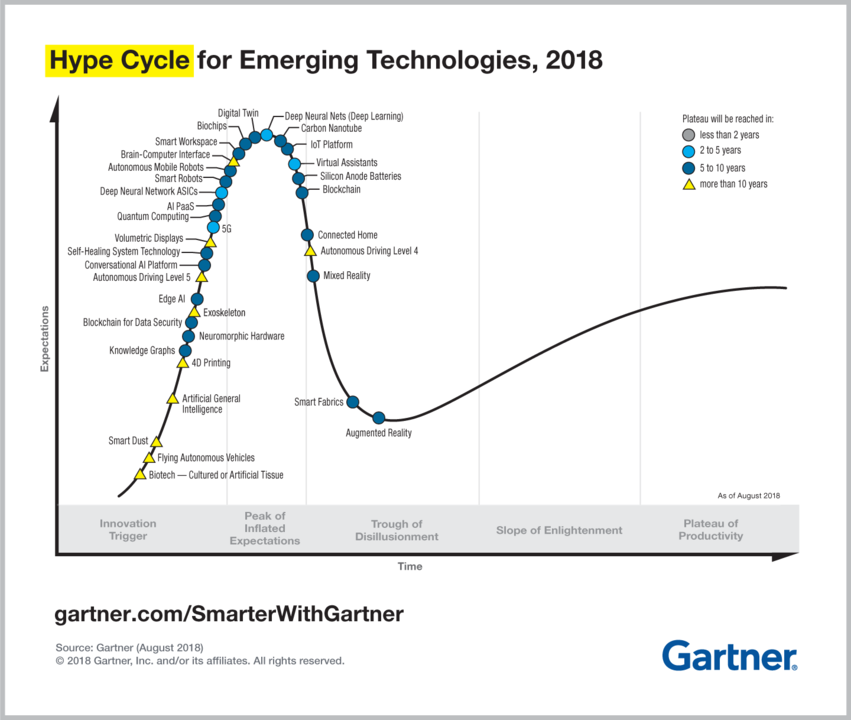
The Gartner Hype Cycle over the years
If you’ve ever seen me present Deloitte’s TMT Predictions report, you know I often start with a look at the most recent version of Gartner’s Hype Cycle chart: the 2018 edition is the cover image for this article. Over the years, many people have asked me “How useful or accurate has the Hype Cycle been over the years?”
Gartner has been publishing these annually since 2000, and last week Visual Capitalist published a useful infographic looking at technologies that were said by Gartner to be at the peak of the Hype Cycle for each of the 19 editions published so far (image below.) They provide their own analysis, but I have a few thoughts of my own, but you have to scroll down past the infographic to read them!
#1: Some technologies surpass the hype. 4G wireless networks (2010) and cloud computing (2009) are both trillion-dollar industries today. Neither really went through the classic Gartner “trough of disillusionment” and have been consistently hot trends for a decade now. Being at the peak of the Hype Cycle isn’t necessarily a bad thing, or a predictor of an imminent collapse.
#2: Some technologies follow the classic Hype Cycle almost perfectly. 3D printing (2012) was definitely over-hyped. But although the “factory in every home” hype did not ever happen (and it still looks unlikely to me) enterprise 3D printing came out of the trough quite nicely, and will soon be a $3 billion industry, growing at 12-13% per year, and is being used across many industries for all of prototypes, intermediate parts and sometimes even final parts. (Pat on the back time: we predicted the failure of the consumer market and the success of the enterprise market back in 2012, the same year Gartner had it peaking in terms of hype.)
#3: Some technologies are overhyped, and never fulfill their promise. E-book readers (2009) and BYOD (Bring Your Own Device, 2012) are great examples. Devices like the Kindle weren’t a total washout, but the number of people who own them remains niche (20% or so), eBook sales have been declining for years, and print book sales are rising…even with young readers 18-34 years old. Although some companies allow employees to bring their own computers to the workplace, it remains a very infrequent policy. How did Predictions do? We nailed the eReader topic, but goofed on the BYOD trend.
#4: Some technologies may do well one day…but it can take an awfully long time. Podcasting was shown ascending the hype curve in the 2005 edition, and many expected it to be the Next Big Thing soon. Here we are 14 years later, and the industry (although growing) is still less than a billion dollars globally in 2019 (about $850 million), which would be a disappointment to those who expected great things all those years ago. But stay tuned…I am thinking about writing a Prediction on podcasting for our 2020 edition!
Autonomous vehicles (2015) look like they will fit this pattern. Some serious people in the space are now saying that Level 5 autonomy (the no steering wheel kind of car) may NEVER happen globally (CEO of Waymo, and the head of autonomy for VW) but even if they are mistaken and AVs do happen, it won’t likely be for another 10, 20 or even 30 years at scale.
#5: Many technologies never come out of the trough. I am not even talking about augmented reality glasses (2011). Yes, Google Glass was not a success, but there are some interesting enterprise use cases and real-world sales today.
Instead I am thinking of stuff like grid computing (2002.) That was before I joined Deloitte, but I remember people getting excited about grid computing and it not only hasn’t happened yet, no one seems to be talking about it!
Conclusion: You have to do your own work. The Hype Cycle is a great graphic, and a useful visualization. But it is a lousy predictor. Being at the hype peak doesn’t guarantee that a given technology will succeed massively, have more modest success, or vanish entirely. Those thinking about the future of tech need to do their own research, examine the data, do their analysis and make their own call.
As an example, notice that Gartner has machine learning (2016), deep learning (2017) and deep neural networks (2018) at the extreme apex of the Hype Cycle. They keep (slightly) relabelling what has basically been the same trend because a) the hype just keeps getting bigger, and b) there’s no sign of the technology moving down into the trough of disillusionment.
And my own analysis suggests that machine learning will not follow the predicted Gartner curve. But it takes 100s of hours of research and meeting 1000s of clients across all industries to make that call.

Innovation | Strategy | Data Storyteller | Future Studies
5yVery interesting! Came across another---https://www.linkedin.com/pulse/8-lessons-from-20-years-hype-cycles-michael-mullany
S2P Procurement | ESG Certified & Sustainability Advocate | Board Advisor @ REST Centres
5yCurious to see how blockchain technologies will fare - should be interesting!